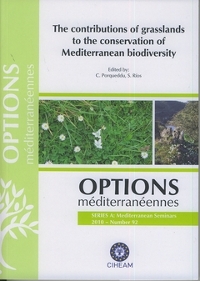| Article précédent | p. 39-43 | Article suivant |
Constraints to improving forage feed resources and their impacts on the dynamics of the cattle breeding in Tunisia
The cattle breeding in Tunisia contributes currently for about 24 percent to the animal production and represents close to 8 percent of the agricultural production. Composed essentially of local races (Brown of the Atlas) and observed mainly in North areas of the country, the bovine farming was supported by favorable climatic conditions. Cattle feeding are based on permanent pastures complemented by forage production integrated with cereal crops. Since the 1960s, the bovine population was progressively subjected to important transformations that affect the composition and the structure of the herd and were accompanied by a spatial extension of the bovine livestock all over the country. Now, the question is if this geographic extension of the bovine livestock is accompanied or not by a similar extension of forage areas. It seems to be difficult to meet this objective on the light of the current tendencies that seem to draw and because of the natural differences in climate conditions between the regions. To apprehend the description typologies of the spatial distribution or regional segmentation of the forage areas in Tunisia, a detailed study on statistics and the available data must be carried out using the most appropriate tools and techniques. The objectives of this work is to examine, through statistics, the impact of these spatial extensions of the cattle breeding, the main source of meat and milk in the country, on the abundance of forage production and its capacity to maintain the regional feed/herd balance.
L'élevage bovin tunisien contribue actuellement pour environ 24 pour cent à la production animale et représente près de 8 pour cent de la production agricole. A partir des années 60, cet élevage, constitué essentiellement de races locales, conduit en extensif dans les régions Nord du pays et basé sur un pâturage permanent complémenté par une production fourragère bien intégrée à la culture céréalière, a subi d'importantes transformations touchant la composition, les effectifs et l'extension spatiale du cheptel à presque toutes les régions du pays. La question qui se pose actuellement est de savoir si cette extension géographique est accompagnée d'une extension similaire des superficies dédiées à la production fourragère, jusqu'ici en relative concordance, ou si cet objectif est difficile à atteindre étant donné les tendances actuelles qui semblent se dessiner. Pour mieux appréhender la description typologique de la répartition spatiale ou encore la segmentation régionale des superficies fourragères en Tunisie, une étude détaillée sur les statistiques et les données disponibles doit être réalisée à l'aide des outils techniques appropriés. Ce travail essaie d'examiner, à partir des statistiques, l'impact de ces extensions spatiales de l'élevage bovin, qui assure l'essentiel de la production de viande et de lait dans le pays, sur l'abondance de la production fourragère et alimentaire et sa capacité à maintenir l'équilibre régional alimentation/effectifs.
- [ Afficher ]
- [ Télécharger ]
- [ Exporter la citation ]
Vous pouvez télécharger la citation au format :
- [ Imprimer ]
-
Mots-clés
BOVIN, DISTRIBUTION GEOGRAPHIQUE, DONNEE DE PRODUCTION, DONNEE STATISTIQUE, EFFECTIF DU CHEPTEL, PLANTE FOURRAGERE, SURFACE, TUNISIECiter cet article
Jaouad M. Constraints to improving forage feed resources and their impacts on the dynamics of the cattle breeding in Tunisia. In : Porqueddu C. (ed.), Ríos S. (ed.). The contributions of grasslands to the conservation of Mediterranean biodiversity. Zaragoza : CIHEAM / CIBIO / FAO / SEEP, 2010. p. 39-43. (Options Méditerranéennes : Série A. Séminaires Méditerranéens; n. 92). 13. Meeting of the Sub-Network on Mediterranean Forage Resources of the FAO-CIHEAM International Network for the Research and Development of Pasture and Forage Crops, 2010/04/07-10, Alicante (Spain). http://om.ciheam.org/om/pdf/a92/00801211.pdf



